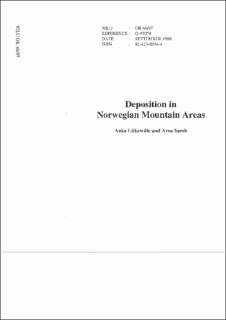| dc.description.abstract | Air pollutant deposition to mountain areas may increase strongly with elevation. The stations within the Norwegian air pollutant monitoring program are located below the timberline. However, pollutant concentrations in precipitation do obviously not increase with elevation. Thus, the present method of mapping sulphur and nitrogen deposition based on interpolated fields of measured precipitation amounts and mean weighted concentrations is accurate to assess deposition loads on the regional scale. It can be assumed that droplet and rime ice deposition in Norwegian mountain areas contributes with only 10% to total pollutant loads. The principal deposition mechanism for droplets is similar to those for particles (dry deposition). General knowledge about the chemical composition and size typical for fog and cloud droplets at different elevations in mountain areas allows to assess deposition velocities and thus input loads on large scales (e.g., 50 x 50 km grid cells). | |
